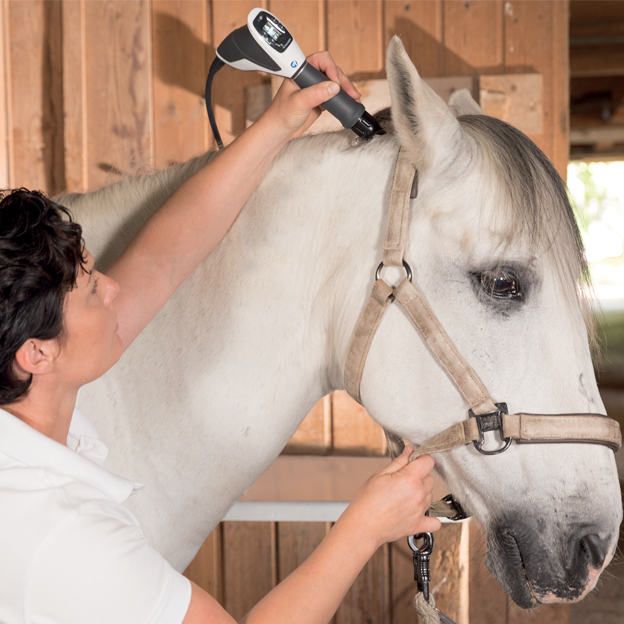Assessing the Performance of Laser Therapy in Horse Treatment for Injury Rehab
The assessment of laser treatment's effectiveness in equine injury recovery pivots on several factors, including healing time, discomfort mitigation, and tissue regrowth. Scientific researches suggest noteworthy improvements in problems like tendonitis and osteoarthritis, credited to enhanced mobile feature and elevated ATP production. Veterinarians regularly observe superior results with laser therapy contrasted to standard methods, placing it as a vital element in equine care. However, the requirement for continuous monitoring and personalized therapy plans can not be overstated. What details clinical evidence sustains these claims, and how do veterinarians implement these protocols in method?
Understanding Laser Treatment
Laser treatment has become a pivotal device in vet medicine, particularly in the therapy of equine problems. Understood for its non-invasive nature and efficacy, laser therapy entails the application of certain wavelengths of light to promote tissue fixing and minimize inflammation. This therapeutic method is progressively favored for its capacity to speed up the healing procedure in steeds struggling with a range of musculoskeletal injuries and persistent conditions.
The main device behind laser therapy is its capability to boost cellular functions. Furthermore, laser treatment promotes vasodilation, enhancing blood circulation and oxygen distribution to damaged tissues, therefore expediting recovery.
In equine medication, laser treatment is particularly useful for problems such as tendonitis, osteoarthritis, and wound recovery. The strategy is lauded for its pain-relieving properties, enabling equines to reclaim movement and function more quickly. Vets additionally appreciate its very little adverse effects compared to various other therapy modalities, making it a dependable and risk-free alternative for equine treatment.

Exactly How Laser Treatment Works

Upon absorption, these photons activate a series of biochemical changes, boosting mitochondrial feature and bring about increased adenosine triphosphate (ATP) production. This surge in ATP increases mobile metabolic process, promoting tissue repair and regeneration. Furthermore, laser therapy regulates inflammatory actions by influencing cytokine degrees and lowering oxidative tension, thus relieving pain and swelling.
Another significant facet of laser therapy is its function in improving microcirculation. The treatment advertises vasodilation, improving blood circulation and oxygen delivery to broken cells (Equine Therapy). This assists in the removal of cellular particles and supports the expansion of fibroblasts and collagen synthesis, essential for injury recovery
Scientific Proof
The efficiency of laser treatment in equine therapy has actually been substantiated through various medical research studies, showcasing its restorative prospective across a range of conditions. A study conducted by Turner et al. (2012) demonstrated that horses treated with low-level laser therapy (LLLT) for ligament injuries showed increased recovery contrasted to those getting traditional treatments.
Similarly, research by Johnson and colleagues (2015) concentrated have a peek at this site on equine muscular tissue injuries, exposing that laser treatment substantially accelerated muscle mass fiber regeneration and reduced muscle stiffness. These searchings for were corroborated by histological evaluations revealing enhanced muscle cells company. Additionally, medical assessments have actually revealed that laser therapy can alleviate persistent problems such as osteoarthritis. A research study by Smith et al. (2018) reported that horses with osteoarthritic joints experienced notable discomfort relief and raised series of motion adhering to a program of laser therapy sessions.
Vet Insights

Vets likewise appreciate the adaptability of laser treatment. It can be utilized for a vast array of problems, from shallow wounds to deeper musculoskeletal injuries. Dr. Emily Brown highlights its utility in treating problems like tendonitis and osteo arthritis, where standard treatments usually fail. She mentions that laser therapy can be tailored to the specific demands of each steed, making published here sure ideal results.
Moreover, vets value the capability to integrate laser treatment with various other treatment methods. This multimodal strategy can improve overall therapy effectiveness, providing a thorough option for equine rehabilitation. Such recommendations from experienced professionals emphasize the growing approval and application of laser therapy in equine medicine.
Practical Factors To Consider
An essential facet of carrying out laser therapy in equine therapy involves comprehending the useful factors to consider that ensure its efficiency and safety. It is crucial to choose the ideal laser gadget, as numerous types differ in wavelength, power, and infiltration depth. Vets must be skilled in these criteria to tailor treatment methods efficiently to every injury kind
Furthermore, the regularity and period of laser therapy sessions require mindful planning to maximize restorative advantages while decreasing any prospective damaging effects. Constant surveillance of the horse's reaction to therapy can lead necessary modifications in the treatment routine. Developing a safe and controlled atmosphere during therapies is additionally necessary to avoid unexpected exposure to laser emissions, which could harm both the equine and the handler.
Training and accreditation of workers providing laser treatment are extremely important to ensure proper technique and to support safety requirements. Furthermore, preserving precise documents of each session, consisting of laser setups and observed results, is essential for evaluating the overall site web effectiveness of the treatment and for making data-driven decisions.
Verdict
Laser treatment has arised as an efficient modality in equine injury recovery, providing significant advantages in recovery time, discomfort relief, and cells healing. For ideal results, constant monitoring and customized treatment procedures remain crucial in leveraging the full possibility of laser therapy in equine treatment.
Comments on “Equine Therapy for Trauma Recuperation: How Steeds Help Heal Emotional Wounds”